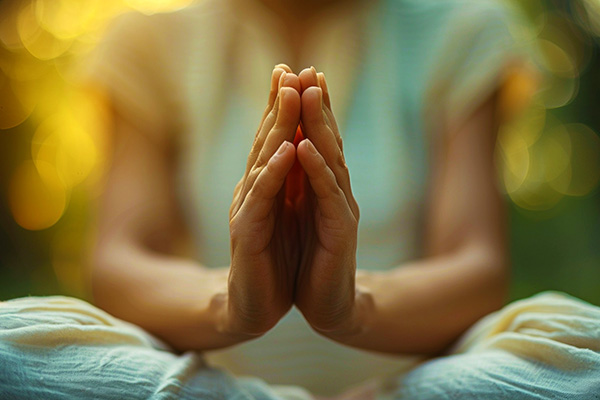Seeing The Spiritual Essence In Others
 My world was turned upside down when my father was diagnosed with pancreatic cancer. For seven agonizing months in 2005, I became his caregiver, managing the extreme emotional and physical toll of his illness.
My world was turned upside down when my father was diagnosed with pancreatic cancer. For seven agonizing months in 2005, I became his caregiver, managing the extreme emotional and physical toll of his illness.
Even the hospice staff, experienced in end-of-life care, commented at the time that my father was not an easy patient to care for. Their observation confirmed my own feelings on the matter and highlighted the unique challenges of the difficult karmic relationship I had with my father.
Throughout this stressful time, I held out hope for a miracle. I felt compelled to seek guidance, but unfortunately Spirit revealed a timeline of six to twelve months. This devastated me at the time, but I’ve since come to accept that arrivals and departures are part of every soul’s journey. Spirit was simply confirming a poignant truth: at some point we are all called home to the spirit realm.
Despite his resistance to any form of treatment, my father allowed a trusted colleague of mine, a master in his healing modality, to visit our home weekly for body alignment sessions. These sessions became a turning point — not only for my father, but for me as well.
During their second session, my healer friend shared an observation that struck a deep chord. He sensed an immense amount of bitterness and resentment in my father, energies he had perceived without any prior knowledge of my father’s emotional state or life history. He then offered me a piece of wisdom that changed the way I viewed not only my father, but all of my relationships: “Try to see only the true spiritual essence that is your father.”
At first this advice seemed abstract, but over time it became a guiding principle in my life and work. By focusing on his spiritual essence — the pure, untainted soul beneath the layers of pain and fear — I was better able to interact with him from a place of compassion rather than reaction or frustration. This shift in perspective didn’t just improve our relationship; it improved my understanding of human relationships as a whole.
When we seek to discover the best in others, we somehow bring out the best in ourselves ~ William Arthur Ward
The Truth About Buttons And Triggers
Through this journey, I realized that many of the negative emotions we encounter in others are rooted in fear — fear built up over years of unresolved pain, disappointment, and struggle. When someone lashes out or “pushes our buttons,” they’re often projecting their own inner discomfort.
We have a choice about how to respond: we can take it personally and feel victimized, or we can see it as an opportunity for growth and healing.
These emotional triggers are deeply connected to our own thoughts, beliefs, past experiences, and unhealed wounds. They’re only activated because something inside us resonates with what’s being said or done. This understanding changed my perspective. Instead of blaming others for “pushing my buttons” or “triggering me,” I began to explore the emotional charge within myself that allowed those buttons or triggers to exist in the first place.
How To Deal With Difficult People
The healer who worked with my father also taught me a simple yet profound technique for dealing with these triggers. He explained that no one could push my buttons if I didn’t already have an emotional charge attached to them.
He suggested that I think of my father, or anyone else who triggers me, as “green.” Green is a neutral color to me: peaceful, calm, and free of emotional associations. By imagining my father as this color when he began to trigger me, I found myself responding with calm neutrality rather than frustration or hurt.
It may sound unconventional, but this visualization technique has worked wonders for me. Whenever I feel someone is about to push my buttons, I mentally “paint” them green. This simple act creates a buffer that allows me to stay grounded and calm.
Since then, I have adopted additional empowering strategies and techniques to help me deal with triggering situations or people who push my buttons:
Daily energy protection: Begin your day with an energy protection technique, such as visualizing a protective bubble of light around you. This helps shield you from absorbing other people’s negativity or emotional turmoil.
Set boundaries: Clearly define and communicate your boundaries. Boundaries are not about controlling others, but about protecting your energy and emotional well-being. Firm yet compassionate boundary setting is key.
Practice visualization: Visualize the person as neutral energy or a calming color (such as green). This mental exercise helps you detach emotionally and view them without judgment, reducing the intensity of their words or actions.
Use affirmations: Ground yourself with affirmations such as “I am in control of my emotions” or “I choose peace over conflict.” Repeating these phrases silently or out loud can help you stay centered.
Pause and breathe: When triggered, take a moment to pause and focus on your breath. Deep, intentional breaths help regulate your nervous system, reduce the fight-or-flight response, and give you space to respond thoughtfully.
Respond, don’t react: Practice responding thoughtfully rather than reacting impulsively. A calm, measured response disarms the other person and gives you a sense of control over the situation.
Shift your perspective: Ask yourself, “What pain, fear, or insecurity might they be expressing?” Seeing their actions as a reflection of their inner struggles can foster empathy and help you disengage emotionally.
Redirect the energy: If the situation escalates, gently change the subject or disengage. For example, you might say, “I see where you’re coming from. Let’s revisit this later,” and physically remove yourself if necessary.
Grounding techniques: When emotions begin to rise, use grounding exercises such as pressing your feet firmly into the floor, holding a comforting object, or focusing on a physical sensation (such as the feel of your hands on your lap).
Compassionate detachment: Remind yourself that you cannot control others, only your response to them. By practicing compassionate detachment, you acknowledge their feelings without absorbing or owning them.
Mirror work: Use the interaction as an opportunity for self-reflection. Ask yourself, “Why does this bother me? What unresolved issue or belief is it triggering in me?” Often their actions reflect something we need to address in ourselves.
Each of these techniques empowers you to maintain your balance and reclaim your emotional sovereignty, no matter what the circumstances.
The eye through which I see God is the same eye through which God sees me; my eye and God’s eye are one eye, one seeing, one knowing, one love ~ Meister Eckhart
The Ancient Wisdom Of Namaste
Navigating difficult relationships and emotional triggers also brought me to the spiritual concept of namaste. This greeting has ancient roots in Indian spirituality, particularly in Hinduism, Buddhism, and Jainism. The word “namaste” comes from Sanskrit and combines nama (to bow) and te (you), which translates to “I bow to you.”
It is traditionally used as a respectful greeting or prayer to deities, elders, or revered individuals to convey the idea that “the divine in me honors the divine in you,” emphasizing a spiritual connection between two parties that transcends this physical realm. The greeting is traditionally accompanied by a gesture called anjali mudra, in which the palms of the hands are pressed together in front of the heart, symbolizing respect, humility, compassion, and recognition of shared divinity.
At its core, namaste is an acknowledgment of the shared divinity within all beings. It invites us to look beyond a person’s actions, behaviors, or emotional layers and recognize their true spiritual essence — the light within that is untouched by fear, anger, or resentment.
When someone pushes your buttons, it can be difficult to see them through this lens. However, adopting a “namaste mindset” can transform the way you perceive and respond to challenging interactions. Instead of reacting to their external behavior, you can choose to honor their spiritual essence, just as my healer friend advised me to do with my father.
Practicing namaste in your daily life doesn’t require a formal gesture or spoken words. It can simply be a mental and emotional shift. When faced with a triggering situation, silently say “namaste” to remind yourself that your divine essence exists beyond your current actions. Recognize that your behavior may be due to fear, pain, or past experiences. While this doesn’t excuse harmful actions, it can help you approach the situation with empathy rather than judgment.
Every interaction is an opportunity for growth — for you and for the other person. By honoring their divine essence, you create space for healing and transformation, even if only within yourself. Incorporating Namaste into your spiritual practice can deepen your relationships and cultivate inner peace. It encourages a heart-centered approach to life and reminds us that we are all connected at our core.
With this awareness, even the most difficult interactions become opportunities to honor the divine in others — and in yourself.
A Lesson For All Relationships
The insights I gained during this challenging time have stayed with me and shaped how I navigate all relationships — whether with family, friends, or strangers. Relationships, I’ve learned, are one of the most complex aspects of life. They are mirrors that reflect not only the other person’s emotions, but also our own.
When someone triggers us, it’s an invitation to look within. What belief, fear, or unresolved emotion is being activated? By embracing this self-awareness and practicing neutrality, we can transform conflict into an opportunity for healing and growth.
Even now, I sometimes laugh at myself when I mentally “green” someone, but the results speak for themselves. It’s not just about diffusing tension; it’s about seeing beyond the layers of fear and pain to the spiritual essence of the other person. And in the process, we also discover our own deeper layers.
|
|

Leave a Reply